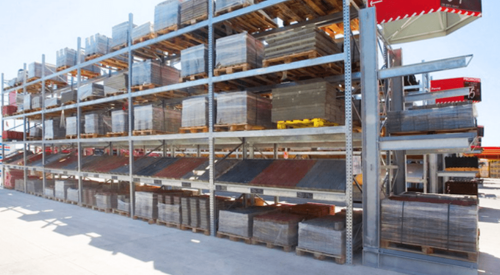Having long ago stopped being seen as simply providers of "trailer" homes, the manufactured housing industry has made huge strides during the past two decades. With designs that mirror conventional stick-built homes at a much lower price, sales of manufactured models have soared to levels that now represent about 25 percent of all new home sales.
| The multi-unit sector of the manufactured housing industry is expected to grow more rapidly than single-unit, a new report says. |
But despite these gains, industry leaders say manufactured housing has been increasingly limited by a federal act that has governed and helped grow the sector since 1976. In 2000, they are counting on enactment of a new law that will give industry manufacturers, retailers and consumers a greater role in updating technical aspects of the existing code and provide added funding for the U.S. Department of Housing and Urban Development (HUD) to administer the program.
"We have been working within not only the factory-built housing industry, but also with home builders, with HUD, and of course with members of Congress on Capitol Hill," says Walt Young, chairman of the country’s largest manufactured housing firm, Champion Enterprises. "It has been an effort that has been going on for at least three years and some would say for 10--to improve and protect the federal housing code, which, in this day of automation and factory building, is becoming more and more of the mainstream of housing."
According to Chris Steinbert, president of the Manufactured Housing Institute, HUD supervision of the original act has suffered mainly from a lack of resources and staff, which--due to budget cuts--has diminished over the years from 35 full-time staffers to its present level of eight. To remedy this, nearly all of the 88 manufacturers nationwide have agreed to a significant, but as yet undetermined, increase in label fees for each unit they produce. Presently HUD receives approximately $24 for each single section house or unit produced to fund its supervision of the act. Under pending Senate and House versions of The Manufactured Housing Act of 1999, these increased fees would continue to be the sole basis of support for the expanded program within HUD.
"This industry cannot progress beyond where it is now and innovate at the speed that it should and keep up-to-date with current codes and standards unless the current situation changes," says Steinbert. "And that situation needs to give HUD more personnel--more people to address these issues. And we need a group of knowledgeable people making recommendations on what needs to be done."
Under the new law, the HUD secretary would be required to review and act upon the recommendations of a consensus committee made up of manufacturers, home buyers, retailers and other non-interested housing experts. Presently overseen by the National Fire Protection Association at the direction of HUD, the committee’s recommendations in recent years have gone largely unreviewed by the cabinet-level housing secretary. Most technical revisions by HUD to the standards by which the homes are built have come in response to natural disasters, says Jim Keller, a factory-built housing expert with the Indiana Manufactured Housing Association.
| The Growth in Starts | ||
| Year | Units Shipped | % of Total Starts |
| 1991 | 171,000 | 17% |
| 1992 | 211,000 | 17% |
| 1993 | 254,000 | 18% |
| 1994 | 304,000 | 20% |
| 1995 | 340,000 | 24% |
| 1996 | 363,000 | 24% |
| 1997 | 353,000 | 24% |
| 1998 | 373,000 | 24% |
| Source: Manufactured Housing at the Millennium, The Coalition to Improve the Manufactured Housing Act, 1999. | ||
One example of an area that needs technical review, says Keller, is the requirement that each unit be built with a steel undercarriage to facilitate transportation. The requirement is one of many that are seen as outdated in a document that was mostly written in 1974 or earlier. And it recalls a time when the principal benefit of a manufactured home was its portability to other sites. The reality is that once factory-built homes are sited, they are rarely relocated and the undercarriage is largely unneeded. A revision to the undercarriage requirement, he says, would free manufacturers to use lighter materials and in turn make it easier to innovate in designing future manufactured homes, especially those with multi-units and levels.
But most examples of needed revisions in the HUD-Code are more mundane, says Bill Lear, general counsel for Fleetwood Enterprises, one of the industry’s largest manufacturers. "We are in a position technically, where we are building to a National Electrical Code standard that is two versions and six years old, and that is dumb."
| Larger Manufactured Homes | ||
| Year | Average Size (Square Feet) | |
| 1991 | 1225 | |
| 1992 | 1255 | |
| 1993 | 1295 | |
| 1994 | 1330 | |
| 1995 | 1355 | |
| 1996 | 1380 | |
| 1997 | 1415 | |
| 1998 | 1450 | |
| Source: Manufactured Housing at the Millennium, The Coalition to Improve the Manufactured Housing Act, 1999. | ||
Regulatory Reform
While regulation of the construction of site-built and even modular homes falls under the exclusive purview of state and local government lawmakers, many see federal preeminence as the greatest virtue of the original manufactured housing act. In putting the federal government in charge, the law helped usher in a new era of housing affordability by allowing factory-built housing firms to build to one set of specifications instead of 50 or more.
But proponents of the revised act now making its way through Congress want to remedy an unintended consequence of such a vast supervisory role for HUD. To date only one organization has been contracted by HUD to supervise the multiple level of inspections that must be made in locations around the country—The National Conference of States on Building Codes and Standards (NCSBCS). According to MHI’s Chris Steinbert, the new law would require the use of multiple outside sources to execute regulatory functions.
These regulatory functions would largely remain the same. The new law would continue inspections at each new manufacturing plant for adherence to approved home designs. It would also call for periodic inspections of plants for adherence to an approved quality assurance regimen. Likewise, each home or unit will continue to be inspected at some point during manufacturing. And finally, inspection agencies will be subject to performance reviews.
| The proposed federal law would leave inspections to state and local authorities but seeks to add to the number of monitoring contracts. |
Congressional Action
According to MHI, the legislation stands a good chance of passage during the first quarter of 2000. Both House and Senate versions of the rewrite is expected to be reviewed by committees and then slated for a vote by the end of January, says MHI’s legislative coordinator Brian Cooney.
The House version of the legislation has been bundled together on an omnibus housing bill. On the Senate side, the bill stands alone.
Says Cooney, "The only way this bill is not going to pass next year is if we run out of time somehow and that is our biggest fear."
--Patrick L. O’Toole












